Pricing Guides & Dictionary of Makers Marks for Antiques & Collectibles

A few examples of appraisal values for
DIVISIONS
Search our price guide for your own treasures
-
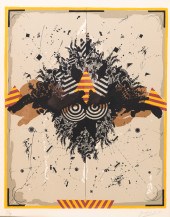 "DIVISION" PRINT, GEORGES DUSSAU.
"DIVISION" PRINT, GEORGES DUSSAU. Born 1947. Lithograph on paper, signed and numbered 35/99. Abstract. With COA. Framed, 29.25"h. 24.25"w.
"DIVISION" PRINT, GEORGES DUSSAU.
"DIVISION" PRINT, GEORGES DUSSAU. Born 1947. Lithograph on paper, signed and numbered 35/99. Abstract. With COA. Framed, 29.25"h. 24.25"w. -
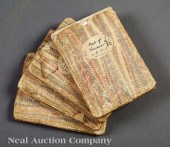 [Map of France] "Carte de la France
[Map of France] "Carte de la France Divisee en 85 Departments et subdivisee en Districts avec les Chefs-lieux de Cantons Presentee a l'Assemblee Nationale" 1791 by Pierre de Belleyme engraved segmented map on linen with original outline color in four marbleized slipcases with large decorative title cartouche total size 48 in. x 64 together with a large 16 sheet chromolithograph map of Paris by L. Wuhrer c. 1900 lacking 12th arrondisement each sheet 24 in. x 28 in.
[Map of France] "Carte de la France
[Map of France] "Carte de la France Divisee en 85 Departments et subdivisee en Districts avec les Chefs-lieux de Cantons Presentee a l'Assemblee Nationale" 1791 by Pierre de Belleyme engraved segmented map on linen with original outline color in four marbleized slipcases with large decorative title cartouche total size 48 in. x 64 together with a large 16 sheet chromolithograph map of Paris by L. Wuhrer c. 1900 lacking 12th arrondisement each sheet 24 in. x 28 in. -
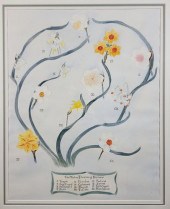 WATERCOLOR ON PAPER "THE TWELVE
WATERCOLOR ON PAPER "THE TWELVE DIVISIONS OF NARCISSUS"...Watercolor on Paper "The Twelve Divisions of Narcissus" , depicting the Trumpet, Large Cupped, Small Cupped, Double, Triandrus, Cyclamineus, Tonquila, Tazetta, Poeticus, Species, Split Cupped, Miscellaneous, initialed lower right, matted and framed 19.5 in. x 15.5 in. Framed 28 in. x 24 in. Condition: Items may have wear and tear, imperfections or the effects of aging. Please contact the gallery for further details prior to bidding. Any condition statement given as a courtesy should not be treated as fact.
WATERCOLOR ON PAPER "THE TWELVE
WATERCOLOR ON PAPER "THE TWELVE DIVISIONS OF NARCISSUS"...Watercolor on Paper "The Twelve Divisions of Narcissus" , depicting the Trumpet, Large Cupped, Small Cupped, Double, Triandrus, Cyclamineus, Tonquila, Tazetta, Poeticus, Species, Split Cupped, Miscellaneous, initialed lower right, matted and framed 19.5 in. x 15.5 in. Framed 28 in. x 24 in. Condition: Items may have wear and tear, imperfections or the effects of aging. Please contact the gallery for further details prior to bidding. Any condition statement given as a courtesy should not be treated as fact. -
 'SECOND DIVISION REGULARS
'SECOND DIVISION REGULARS A.E.F.', 'THE GREAT WAR FOR CIVILIZATION', AND OTHER MEDALS AND PERSONAL ARTICLES, INCLUDING EVANS HAND-ETCHED ENAMELED BOX'Second Division Regulars A.E.F.', 'The Great War for Civilization', and Other Medals and Personal Articles, Including Evans Hand-Etched Enameled Box,,
'SECOND DIVISION REGULARS
'SECOND DIVISION REGULARS A.E.F.', 'THE GREAT WAR FOR CIVILIZATION', AND OTHER MEDALS AND PERSONAL ARTICLES, INCLUDING EVANS HAND-ETCHED ENAMELED BOX'Second Division Regulars A.E.F.', 'The Great War for Civilization', and Other Medals and Personal Articles, Including Evans Hand-Etched Enameled Box,, -
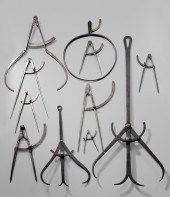 Eleven Dividers one marked "IJ
Eleven Dividers one marked "IJ Bicknell", 6-1/4 in.; one with punched decoration, dated 1827, 18-1/4 in.; one with brass arc, signed in script "J.W. Hinks & Co.", 18 in.; one with decorated shafts, 15 in.; one with hand-tooled divisions on arc, 21-3/4 in.; one marked "L&S" and "OC", 17-1/2 in.; one marked "Peck, Stowe & Wilcox(?)/East Berlin, Conn.", 18-1/4 in., 6-1/4 in. to 40 in.,
Eleven Dividers one marked "IJ
Eleven Dividers one marked "IJ Bicknell", 6-1/4 in.; one with punched decoration, dated 1827, 18-1/4 in.; one with brass arc, signed in script "J.W. Hinks & Co.", 18 in.; one with decorated shafts, 15 in.; one with hand-tooled divisions on arc, 21-3/4 in.; one marked "L&S" and "OC", 17-1/2 in.; one marked "Peck, Stowe & Wilcox(?)/East Berlin, Conn.", 18-1/4 in., 6-1/4 in. to 40 in., -
 Books: History of the 77th
Books: History of the 77th MetropolitanDivision published in 1919
Books: History of the 77th
Books: History of the 77th MetropolitanDivision published in 1919 -
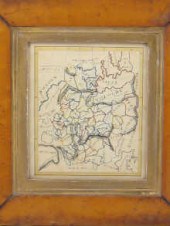 A 19th century map of the divisions
A 19th century map of the divisions of Russia. 14 x 17 cm.
A 19th century map of the divisions
A 19th century map of the divisions of Russia. 14 x 17 cm. -
 A brass two-division stick stand
A brass two-division stick stand with turned finials, 46cm wide
A brass two-division stick stand
A brass two-division stick stand with turned finials, 46cm wide -
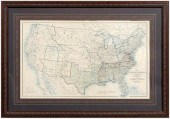 U.S. Civil War map, "Map of the
U.S. Civil War map, "Map of the United States of American showing the boundaries of the Union and Confederate Geographical Divisions and Departments, June 30, 1863", also marked "Atlas to accompany the official records of the Union and Confederate Armies", published by Julius Bien & Company, image 16-1/2 x 27-1/2 in., page 18-1/2 x 29-1/4 in.; faux burlwood frame with modern French mat. Slight browning. Couey Collection.
U.S. Civil War map, "Map of the
U.S. Civil War map, "Map of the United States of American showing the boundaries of the Union and Confederate Geographical Divisions and Departments, June 30, 1863", also marked "Atlas to accompany the official records of the Union and Confederate Armies", published by Julius Bien & Company, image 16-1/2 x 27-1/2 in., page 18-1/2 x 29-1/4 in.; faux burlwood frame with modern French mat. Slight browning. Couey Collection. -
 1797 American Military Roster 2nd
1797 American Military Roster 2nd brigade 2nd division 650th infantry 57th calvary and 53rd artillary framed.
1797 American Military Roster 2nd
1797 American Military Roster 2nd brigade 2nd division 650th infantry 57th calvary and 53rd artillary framed. -
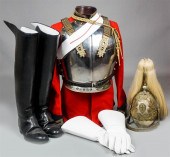 LIFE GUARDS CAVALRY REGIMENT OF THE
LIFE GUARDS CAVALRY REGIMENT OF THE QUEEN'S HOUSEHOLD DIVISIONLIFE GUARDS CAVALRY REGIMENT OF THE QUEEN'S HOUSEHOLD DIVISION, the uniform, including a red tunic with braided ceremonial aiguillettes from the enlisted ranks with Regimental steel helmet with royal cypher affixed having a white horsehair plume together with a steel cuirass and white crossbelt with black ammunition pouch attached in back with cavalry boots and white household cavalry gauntlets
LIFE GUARDS CAVALRY REGIMENT OF THE
LIFE GUARDS CAVALRY REGIMENT OF THE QUEEN'S HOUSEHOLD DIVISIONLIFE GUARDS CAVALRY REGIMENT OF THE QUEEN'S HOUSEHOLD DIVISION, the uniform, including a red tunic with braided ceremonial aiguillettes from the enlisted ranks with Regimental steel helmet with royal cypher affixed having a white horsehair plume together with a steel cuirass and white crossbelt with black ammunition pouch attached in back with cavalry boots and white household cavalry gauntlets -
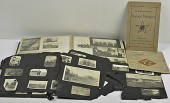 WWI USMC 2nd Division
WWI USMC 2nd Division Photographic Archive Lot includes: two 2nd Div. pamphlets; a replacement photo album; six pages out of the original album. Some nice combat shots. Condition: Very good.
WWI USMC 2nd Division
WWI USMC 2nd Division Photographic Archive Lot includes: two 2nd Div. pamphlets; a replacement photo album; six pages out of the original album. Some nice combat shots. Condition: Very good. -
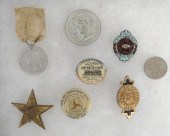 Lot (7) Mass. Division Medals &
Lot (7) Mass. Division Medals & Buttons: 1892 93 94 95 97 98.
Lot (7) Mass. Division Medals &
Lot (7) Mass. Division Medals & Buttons: 1892 93 94 95 97 98. -
 Assortment of parts
Assortment of parts
Assortment of parts
Assortment of parts -
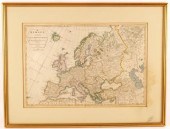 Samuel Dunn/Europe Divided into its
Samuel Dunn/Europe Divided into its Principal States/pub. Laurie & Whittle 12th May 1794, 30.5cm x 45cm and/W Kip after Johanes Norden/Surrey/hand coloured engraving, 28.5cm x 37.5cm (2)
Samuel Dunn/Europe Divided into its
Samuel Dunn/Europe Divided into its Principal States/pub. Laurie & Whittle 12th May 1794, 30.5cm x 45cm and/W Kip after Johanes Norden/Surrey/hand coloured engraving, 28.5cm x 37.5cm (2) -
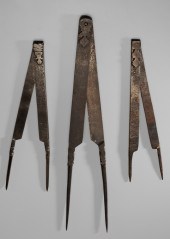 Set of Three Ornate Hand-Wrought
Set of Three Ornate Hand-Wrought Dividers Continental, probably 18th century, all with applied pendant type decoration at pin: one 19 in., repaired pin; one marked "IEA[backwardsN]+BARTISTELLA SCOVRRETC
Set of Three Ornate Hand-Wrought
Set of Three Ornate Hand-Wrought Dividers Continental, probably 18th century, all with applied pendant type decoration at pin: one 19 in., repaired pin; one marked "IEA[backwardsN]+BARTISTELLA SCOVRRETC -
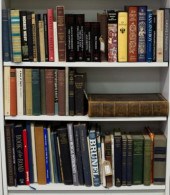 Sundry volumes
Sundry volumes
Sundry volumes
Sundry volumes -
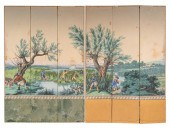 SIX-PANEL ROOM DIVIDERpainted paper
SIX-PANEL ROOM DIVIDERpainted paper mounted on wood, depicting a continuous fox hunting scene; Condition: with tears, stains, and losses to paper throughout; hinges replaced; each panel 79 x 18 inches; Condition:
SIX-PANEL ROOM DIVIDERpainted paper
SIX-PANEL ROOM DIVIDERpainted paper mounted on wood, depicting a continuous fox hunting scene; Condition: with tears, stains, and losses to paper throughout; hinges replaced; each panel 79 x 18 inches; Condition: -
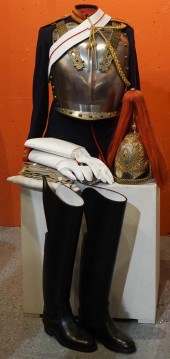 THE BLUES & ROYALS CAVALRY REGIMENT
THE BLUES & ROYALS CAVALRY REGIMENT OF THE QUEEN'S HOUSEHOLD DIVISIONTHE BLUES & ROYALS CAVALRY REGIMENT OF THE QUEEN'S HOUSEHOLD DIVISION, the uniform, including enlisted ranks tunic with blue Napoleonic eagle badge embroidered on left sleeve, a white crossbelt with black ammunition pouch with General Services badge and braided ceremonial aiguillettes, regimental steel helmet with royal cypher affixed, red horsehair plume together with a steel cuirass, appropriate cavalry boots, white household cavalry gauntlets and white leather jodhpurs Provenance: From a Southern Estate
THE BLUES & ROYALS CAVALRY REGIMENT
THE BLUES & ROYALS CAVALRY REGIMENT OF THE QUEEN'S HOUSEHOLD DIVISIONTHE BLUES & ROYALS CAVALRY REGIMENT OF THE QUEEN'S HOUSEHOLD DIVISION, the uniform, including enlisted ranks tunic with blue Napoleonic eagle badge embroidered on left sleeve, a white crossbelt with black ammunition pouch with General Services badge and braided ceremonial aiguillettes, regimental steel helmet with royal cypher affixed, red horsehair plume together with a steel cuirass, appropriate cavalry boots, white household cavalry gauntlets and white leather jodhpurs Provenance: From a Southern Estate -
 US WWII Shoulder Insigina Lot of
US WWII Shoulder Insigina Lot of Two Hundred and Five Lot includes: Division patches rank insignia Corps patches Army Navy Air Corps and Marine. Condition: Very good.
US WWII Shoulder Insigina Lot of
US WWII Shoulder Insigina Lot of Two Hundred and Five Lot includes: Division patches rank insignia Corps patches Army Navy Air Corps and Marine. Condition: Very good. -
 DIVIDED WOODEN TRENCHER. Nineteenth
DIVIDED WOODEN TRENCHER. Nineteenth century, pine. Five segments with traces of sugar (?) as well as later wax. 2.5"h. 37.25"l.
DIVIDED WOODEN TRENCHER. Nineteenth
DIVIDED WOODEN TRENCHER. Nineteenth century, pine. Five segments with traces of sugar (?) as well as later wax. 2.5"h. 37.25"l. -
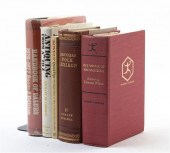 (VARIOUS) A group of two boxes of
(VARIOUS) A group of two boxes of books on various subjects.
(VARIOUS) A group of two boxes of
(VARIOUS) A group of two boxes of books on various subjects. -
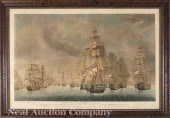 After Robert Dodd (English
After Robert Dodd (English 1748-1816) four aquatints of the Battle of Trafalgar published by J. W. Laird London 1843 distinguished as "Van Division" "Rear Division" "Victory in the Van" and "Victory in the Rear" sight 20 in. x 30 in. attractively framed.
After Robert Dodd (English
After Robert Dodd (English 1748-1816) four aquatints of the Battle of Trafalgar published by J. W. Laird London 1843 distinguished as "Van Division" "Rear Division" "Victory in the Van" and "Victory in the Rear" sight 20 in. x 30 in. attractively framed. -
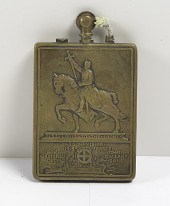 WWI 35th Division Brass Lighter A
WWI 35th Division Brass Lighter A brass cigarette lighter given to the troops at a parade in St. Louis Mo. Marked on the front St. Louis to the Front 35th Division 1918 France. Froma Grateful City to her Gallant Sons. Marked on the back USRF Allied for Liberty. Condition: Some components are missing.
WWI 35th Division Brass Lighter A
WWI 35th Division Brass Lighter A brass cigarette lighter given to the troops at a parade in St. Louis Mo. Marked on the front St. Louis to the Front 35th Division 1918 France. Froma Grateful City to her Gallant Sons. Marked on the back USRF Allied for Liberty. Condition: Some components are missing. -
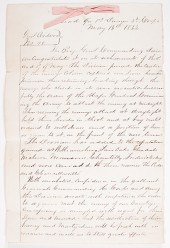 [Civil War - Manuscripts] Brig.
[Civil War - Manuscripts] Brig. General D.B. Birney 1st Division 3d Corps Manuscript General Orders Plus Lot of 2 including manuscript and printed versions of General Orders No. 48 dated May 16 1863 at Headquarters 1st Division 3d Corps. Orders name and congratulate those awarded the division's Kearney Cross for actions at Chancellorsville May 2-3. Manuscript orders are inked on the fronts of 2pp bound together in the upper margin with a pink ribbon. Printed orders are 12pp due to listing of award recipients. Condition: Manuscript orders very good with scattered minor stains. Printed orders with stains in upper margin of first page and some separation at fold lines.
[Civil War - Manuscripts] Brig.
[Civil War - Manuscripts] Brig. General D.B. Birney 1st Division 3d Corps Manuscript General Orders Plus Lot of 2 including manuscript and printed versions of General Orders No. 48 dated May 16 1863 at Headquarters 1st Division 3d Corps. Orders name and congratulate those awarded the division's Kearney Cross for actions at Chancellorsville May 2-3. Manuscript orders are inked on the fronts of 2pp bound together in the upper margin with a pink ribbon. Printed orders are 12pp due to listing of award recipients. Condition: Manuscript orders very good with scattered minor stains. Printed orders with stains in upper margin of first page and some separation at fold lines. -
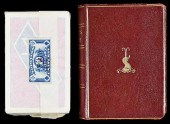 PRESS OF THE WOOLY WHALE “26TH
PRESS OF THE WOOLY WHALE “26TH YANKEE DIVISION” PLAYING...Press of the Wooly Whale “26th Yankee Division” Playing Cards. Mint sealed in original wrapper inside original box. Designed by Alban B. Butler. Issued in commemoration of the signing of the Armistice and also honoring the 103rd Field Artillery. Queens represent the four Mademoiselles made famous by the popular World War I-era song Parlez Vous. Hoch. W30.
PRESS OF THE WOOLY WHALE “26TH
PRESS OF THE WOOLY WHALE “26TH YANKEE DIVISION” PLAYING...Press of the Wooly Whale “26th Yankee Division” Playing Cards. Mint sealed in original wrapper inside original box. Designed by Alban B. Butler. Issued in commemoration of the signing of the Armistice and also honoring the 103rd Field Artillery. Queens represent the four Mademoiselles made famous by the popular World War I-era song Parlez Vous. Hoch. W30. -
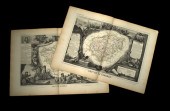 Twenty-Two French Departmental Maps
Twenty-Two French Departmental Maps From Vincent Levasseur's Atlas National Illustre of 1849, each a crown folio, 14-1/4" x 20-5/8" (open), hand-colored and with highly decorated borders featuring meticulous vignettes illustrating the events, lifestyles, products, celebrities and history of the department, including the departments Ain, Aisne, Allier, Basses-Alpes (since 1970 Alpes-de-Haute-Provence), Haute-Alpes, Ardeche, Ardennes, Ariege, Aube, Aude, Aveyron, Cantal, Charente, Charente-Inferieure (since 1941Charente-Maritime), Cher, Correze, Cotes-du-Nord (since 1990 Cotes-d'Armor), Creuse, Doubs, Eure, Eure-et-Loire, and Mayenne.
Twenty-Two French Departmental Maps
Twenty-Two French Departmental Maps From Vincent Levasseur's Atlas National Illustre of 1849, each a crown folio, 14-1/4" x 20-5/8" (open), hand-colored and with highly decorated borders featuring meticulous vignettes illustrating the events, lifestyles, products, celebrities and history of the department, including the departments Ain, Aisne, Allier, Basses-Alpes (since 1970 Alpes-de-Haute-Provence), Haute-Alpes, Ardeche, Ardennes, Ariege, Aube, Aude, Aveyron, Cantal, Charente, Charente-Inferieure (since 1941Charente-Maritime), Cher, Correze, Cotes-du-Nord (since 1990 Cotes-d'Armor), Creuse, Doubs, Eure, Eure-et-Loire, and Mayenne. -
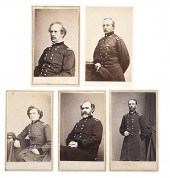 Union Generals Department of the
Union Generals Department of the Gulf Five Civil War CDVs Lot comprising common Anthony-Brady views of three staff officers and two brevet Major Generals who served in the Department of the Gulf under Banks including: Brig. General George L. Andrews Chief of Staff to Gen. Banks (bvt. Maj. Gen. m/o 8/24/65); Brig. General James Bowen (Provost Marshall Gen. Dept of Gulf resigned in wake of Red River disaster bvt. Maj. Gen. 3/13/65); the distinguished Brig. General. Cuvier Grover (WIA 10/19/64 Cedar Creek five wartime brevets to Maj. Gen. died in service 6/6/85 as Colonel 1st US Cav.); Brig. Gen. & Quartermaster General USA Montgomery Meigs (bvt. Maj. Gen. 7/5/64 retired 2/6/82); and Brig. Gen. Thomas W. Sherman (WIA 5/27/63 at Port Hudson two wartime brevets to Maj. Gen. 3/13/65 retired as Maj. Gen. 12/31/70). The Ed Steers Lincolniana & Civil War Collection Condition: CDVs uniformly near VG. With moderate edge wear and slight handling.
Union Generals Department of the
Union Generals Department of the Gulf Five Civil War CDVs Lot comprising common Anthony-Brady views of three staff officers and two brevet Major Generals who served in the Department of the Gulf under Banks including: Brig. General George L. Andrews Chief of Staff to Gen. Banks (bvt. Maj. Gen. m/o 8/24/65); Brig. General James Bowen (Provost Marshall Gen. Dept of Gulf resigned in wake of Red River disaster bvt. Maj. Gen. 3/13/65); the distinguished Brig. General. Cuvier Grover (WIA 10/19/64 Cedar Creek five wartime brevets to Maj. Gen. died in service 6/6/85 as Colonel 1st US Cav.); Brig. Gen. & Quartermaster General USA Montgomery Meigs (bvt. Maj. Gen. 7/5/64 retired 2/6/82); and Brig. Gen. Thomas W. Sherman (WIA 5/27/63 at Port Hudson two wartime brevets to Maj. Gen. 3/13/65 retired as Maj. Gen. 12/31/70). The Ed Steers Lincolniana & Civil War Collection Condition: CDVs uniformly near VG. With moderate edge wear and slight handling. -
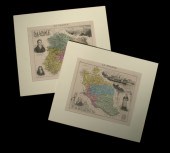 Suite of Five Migeon and
Suite of Five Migeon and Vuillemin Engraved French Departmental Maps, from the Atlas of 1882, the arrondisements hand-colored, the exceptionally fine engraving featuring numerous cities, waterways and forests, with the departmental arms, notable historical persons of the region and architectural landmarks in the surround, the represented departments including Vaucluse, sight 7-3/4" x 9-1/2", Rhone, sight 10" x 8", Marne, sight 8" x 9-1/4", Haut-Rhin, sight 10" x 8", and Gironde, sight 11-1/4" x 9-1/2", each mounted on foam core with artist's board mat.
Suite of Five Migeon and
Suite of Five Migeon and Vuillemin Engraved French Departmental Maps, from the Atlas of 1882, the arrondisements hand-colored, the exceptionally fine engraving featuring numerous cities, waterways and forests, with the departmental arms, notable historical persons of the region and architectural landmarks in the surround, the represented departments including Vaucluse, sight 7-3/4" x 9-1/2", Rhone, sight 10" x 8", Marne, sight 8" x 9-1/4", Haut-Rhin, sight 10" x 8", and Gironde, sight 11-1/4" x 9-1/2", each mounted on foam core with artist's board mat. -
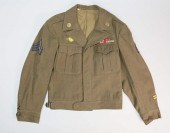 U.S. ARMY WWII 44TH INFANTRY
U.S. ARMY WWII 44TH INFANTRY DIVISION IKE JACKETWWII-era U.S. Army Ike olive drab military jacket, with 44th Infantry Division patch, Sergeant's insignia and overseas service bars on left sleeve; Sergeant's insignia on right sleeve, Ruptured Duck Honorable Service insignia on right breast, medals on left breast, Infantry lapel pins. Size 36R. Shoulders 18"W. Name written on lining below collar.
U.S. ARMY WWII 44TH INFANTRY
U.S. ARMY WWII 44TH INFANTRY DIVISION IKE JACKETWWII-era U.S. Army Ike olive drab military jacket, with 44th Infantry Division patch, Sergeant's insignia and overseas service bars on left sleeve; Sergeant's insignia on right sleeve, Ruptured Duck Honorable Service insignia on right breast, medals on left breast, Infantry lapel pins. Size 36R. Shoulders 18"W. Name written on lining below collar. -
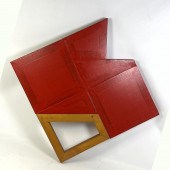 GARY JURYSTA Acrylic and Wood
GARY JURYSTA Acrylic and Wood Wall Sculpture. "Division" 1979. Assembled Joined Canvases with single open wood frame. Dimensions: H: 24 inches: W: 24 inches: D: 1.5 inches --- Condition: Light wear.
GARY JURYSTA Acrylic and Wood
GARY JURYSTA Acrylic and Wood Wall Sculpture. "Division" 1979. Assembled Joined Canvases with single open wood frame. Dimensions: H: 24 inches: W: 24 inches: D: 1.5 inches --- Condition: Light wear. -
 Bindings: A group of leather
Bindings: A group of leather bound volumes, approximately eighteen
Bindings: A group of leather
Bindings: A group of leather bound volumes, approximately eighteen -
 A group of picture frames,
A group of picture frames, various sizes and designs
A group of picture frames,
A group of picture frames, various sizes and designs -
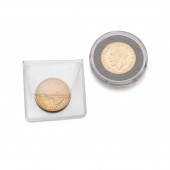 TWO SOVEREIGNS 1911 & 1957(2)
TWO SOVEREIGNS 1911 & 1957(2)
TWO SOVEREIGNS 1911 & 1957(2)
TWO SOVEREIGNS 1911 & 1957(2) -
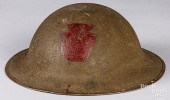 US WWI DOUGHBOY HELMET, 28TH
US WWI DOUGHBOY HELMET, 28TH DIVISIONUS WWI doughboy helmet, 28th Division, with red painted keystone, stamped ZC194 . Competitive in-house shipping is available for this lot. Condition: As expected wear.
US WWI DOUGHBOY HELMET, 28TH
US WWI DOUGHBOY HELMET, 28TH DIVISIONUS WWI doughboy helmet, 28th Division, with red painted keystone, stamped ZC194 . Competitive in-house shipping is available for this lot. Condition: As expected wear. -
 Suite of Five Migeon and
Suite of Five Migeon and Vuillemin Engraved French Departmental Maps, from the Atlas of 1882, the arrondisements hand-colored, the exceptionally fine engraving featuring numerous cities, waterways and forests, with the departmental arms, notable historical persons of the region and architectural landmarks in the surround, the represented departments including Vaucluse, sight 7-3/4" x 9-1/2", Rhone, sight 10" x 8", Marne, sight 8" x 9-1/4", Haut-Rhin, sight 10" x 8", and Gironde, sight 11-1/4" x 9-1/2", each mounted on foam core with artist's board mat.
Suite of Five Migeon and
Suite of Five Migeon and Vuillemin Engraved French Departmental Maps, from the Atlas of 1882, the arrondisements hand-colored, the exceptionally fine engraving featuring numerous cities, waterways and forests, with the departmental arms, notable historical persons of the region and architectural landmarks in the surround, the represented departments including Vaucluse, sight 7-3/4" x 9-1/2", Rhone, sight 10" x 8", Marne, sight 8" x 9-1/4", Haut-Rhin, sight 10" x 8", and Gironde, sight 11-1/4" x 9-1/2", each mounted on foam core with artist's board mat.
...many more examples with full details are available to our members - Learn more


